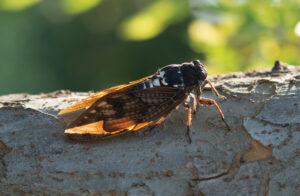 If you have spent any time in Florida during the summer, then you have likely heard the buzzing chorus of cicadas. These loud bugs live high in the trees, making them difficult to spot despite their daily songs heard every year during the spring and summer. Cicadas have one of the longest life spans of any insect with a unique life cycle involving underground hibernation that can last for over a decade. In some northern states, groups of cicadas hibernate together and emerge all at once in huge numbers. Florida has a larger variety with nineteen unique cicada species, each with different life cycles. This guarantees that cicadas emerge in Florida annually, as the different species take turns hibernating and coming up to breed. This intricate ritual is just one aspect that makes cicadas charming.
If you have spent any time in Florida during the summer, then you have likely heard the buzzing chorus of cicadas. These loud bugs live high in the trees, making them difficult to spot despite their daily songs heard every year during the spring and summer. Cicadas have one of the longest life spans of any insect with a unique life cycle involving underground hibernation that can last for over a decade. In some northern states, groups of cicadas hibernate together and emerge all at once in huge numbers. Florida has a larger variety with nineteen unique cicada species, each with different life cycles. This guarantees that cicadas emerge in Florida annually, as the different species take turns hibernating and coming up to breed. This intricate ritual is just one aspect that makes cicadas charming.
Cicadas are insects that look similar to crickets or katydids, but they are more compact and unable to jump. They have two membranous wings and prominent compound eyes. They can grow to be quite large, ranging from 7mm to 57mm long depending on the species. Male cicadas produce their call with drum-like structures, called timbals, on either side of their abdomen. Females are mute. By rapidly flexing a muscle attached to the timbal plate, cicadas cause the structure to pop in and out. The timbal then strikes the timbal plate and produces music like a clacking castanet. Although, cicadas vibrate their timbals at such speeds that it sounds more like a buzzing drone. Male cicadas mainly produce this sound to attract mates, and they can sing uninterrupted for hours on end. Because this call is so loud, there have been reports of female cicadas being mistakenly attracted to lawn mowers and power tools. Males also make a high, shrill call when in distress and clicking noises when they have successfully found a mate.
 The life cycle of a cicada consists of three different stages. First, eggs are laid into small tree twigs by the female. When the nymph hatches, it drops out of the tree onto the ground, where it burrows into the dirt and suckles on the roots of plants. Scientists estimate that Florida’s annual cicadas can live underground for 2 to 5 years, the longest portion of their lives. When they are ready to emerge in the spring or summer, cicadas burrow out of the earth, climb a tree or another nearby surface, and molt from a nymph into a fully-fledged adult. Now winged, the cicada leaves its shed skin behind and goes on to find a mate and produce eggs of its own.
The life cycle of a cicada consists of three different stages. First, eggs are laid into small tree twigs by the female. When the nymph hatches, it drops out of the tree onto the ground, where it burrows into the dirt and suckles on the roots of plants. Scientists estimate that Florida’s annual cicadas can live underground for 2 to 5 years, the longest portion of their lives. When they are ready to emerge in the spring or summer, cicadas burrow out of the earth, climb a tree or another nearby surface, and molt from a nymph into a fully-fledged adult. Now winged, the cicada leaves its shed skin behind and goes on to find a mate and produce eggs of its own.
As mentioned earlier, in more northern states, there are species of perennial cicadas that hibernate underground for up to 17 years before coming up all at once in huge numbers. Scientists have studied these species extensively, tracking each life cycle to predict when the next wave of cicadas will emerge. Each group of cicadas, called a brood, has been mapped out across their native regions, and there is even an app available to the public that tracks when and where each brood will emerge! However, since Florida has many different species of cicadas, scientists have found it difficult to track their individual hibernation cycles. In Florida, some cicadas emerge every year rather than in massive periodic cycles, making it difficult to isolate and study just one species. Although scientists estimate that Florida’s species spend 2 to 5 years underground, it is unknown exactly how long their hibernation cycles last. Due to the lack of periodic cycles and the consistency of their emergence, Florida cicadas are classified as annual.
 With their impressive size and deafening call, cicadas can be an intimidating insect, but they are quite harmless. You are far more likely to run into a hollow molt than an actual cicada, but if you do find one, it will not bite or sting. Cicadas also do not significantly affect crops like locusts do, and they do not harbor parasites that can harm humans or other animals. Cicadas serve as food for many animals, including birds, small mammals, and even other insects.
With their impressive size and deafening call, cicadas can be an intimidating insect, but they are quite harmless. You are far more likely to run into a hollow molt than an actual cicada, but if you do find one, it will not bite or sting. Cicadas also do not significantly affect crops like locusts do, and they do not harbor parasites that can harm humans or other animals. Cicadas serve as food for many animals, including birds, small mammals, and even other insects.
Cicadas also have historical culinary significance. They have been attributed to saving certain Native American groups from starvation in times of hardship and were snacked on by the Ancient Greeks. Even today, cicadas are considered a delicacy in parts of China. Newly emerged adult cicadas are high in protein. They can be eaten roasted, fried, or baked.
Although an elusive insect, the cicada’s fascinating life cycle and history makes it one of the coolest bugs in the Sunshine State. Florida cicadas are still being studied in hopes of understanding the intricacies of their life cycles. When you hear cicadas’ triumphant song this summer, remember that their buzzing call is the fulfillment of a years-long life goal. ![]()
Jessica Fuller
Home and Yard Magazine




